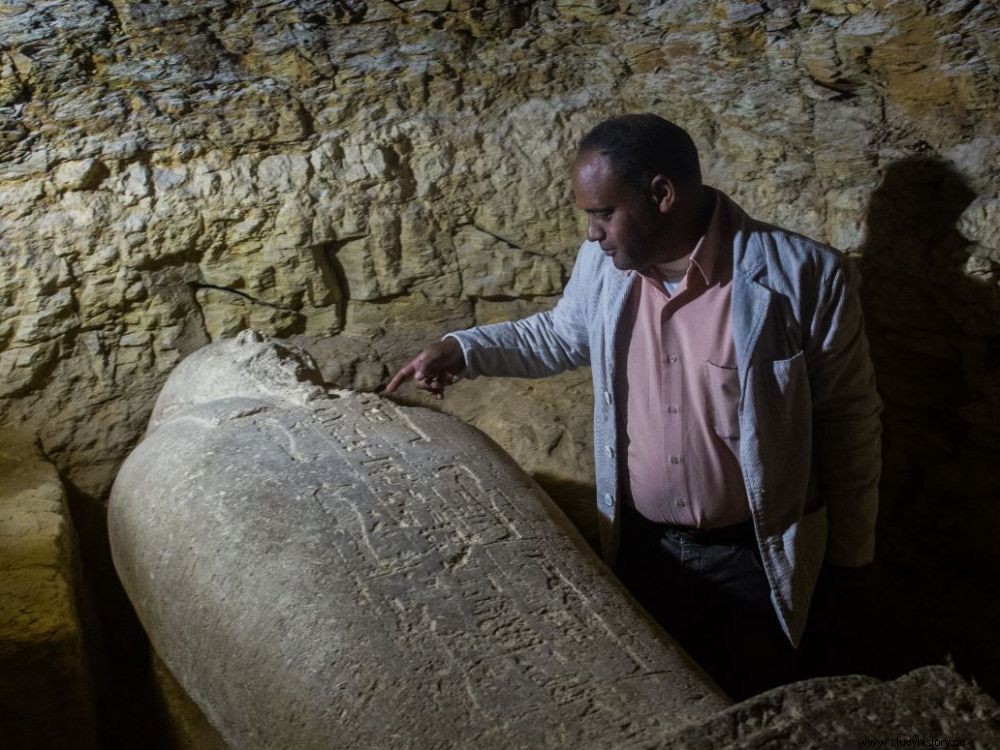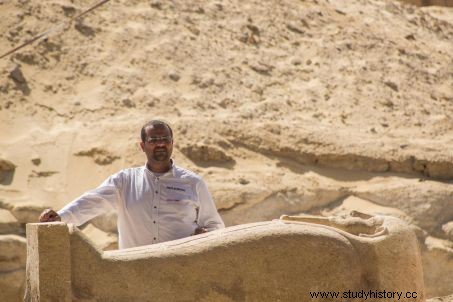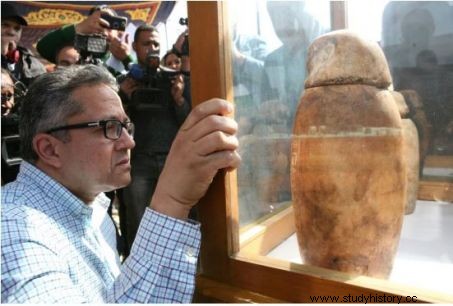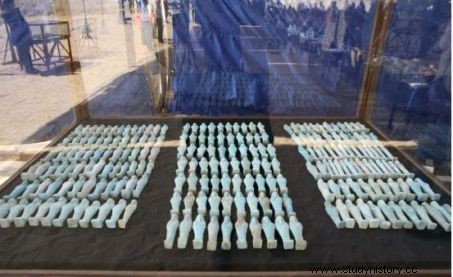More than 2000 years old, an ancient cemetery in Upper Egypt has yielded a number of mummies and around forty imposing sarcophagi carved in limestone.

Anthropomorphic limestone sarcophagus engraved with the name of its owner.
Its occupants will have known only two thousand years of eternity! A vast necropolis has just been unearthed near the town of Al-Minya, south of Cairo. Studied since autumn 2017 by a German and Egyptian team led by Mr. Mostafa Waziri, Secretary General of the Supreme Council of Antiquities (CSA), the announcement of its discovery was made on Saturday February 24, 2018 by Mr. Kaled El-Anany , Minister of Egyptian Antiquities. Coming especially to the scene, the Egyptian official presented the cemetery used for more than 2000 years, from the end of the Pharaonic era (664-332 BC) to the Ptolemaic era (310 BC). C- to 30 A.D.).
 One of forty anthropomorphic limestone sarcophagi. © Fayed El-Geziry /Nurphoto /AFP
One of forty anthropomorphic limestone sarcophagi. © Fayed El-Geziry /Nurphoto /AFP
Located on the edge of the western desert, 6 km from the archaeological site of Tounah el-Gebel and its famous catacombs, the underground cemetery conceals, in addition to numerous mummies, the family tombs of several religious dignitaries, including that of Hersa-Essei , a high priest of the ancient Egyptian god Thoth, the ibis-headed "lord of time". Nearby were four alabaster canopic jars with faces of Horus, believed to contain his mummified internal organs.
 The Minister of Egyptian Antiquities facing the canopic jars of a high priest of Thoth. © Egyptian Ministry of Antiquities.
The Minister of Egyptian Antiquities facing the canopic jars of a high priest of Thoth. © Egyptian Ministry of Antiquities.
One thousand ushebti , funerary statuettes in blue earthenware also accompanied the deceased. Among these finds was also the mummy adorned with necklaces and amulets, of another high priest by the name of Dehuty-Irdy-Es , as well as forty massive limestone sarcophagi, some bearing anthropoid-shaped lids engraved with the names and titles of their owners. "Five years of work will be necessary to complete the study of this necropolis said the Minister of Antiquities. The actual extension of this cemetery could indeed be much greater.
 Ushabtis of blue earthenware. © Egyptian Ministry of Antiquities.
Ushabtis of blue earthenware. © Egyptian Ministry of Antiquities.
Regularly distilled, these high-profile press releases are intended to bring tourists back, by increasing the offer of sites to visit. Several have been leaked in recent months, including that of a previous necropolis encountered in this same region of Tounah el-Gebel in 2017. Since the "2011 revolution", Egypt has faced a sharp drop in tourism , a key sector of its economy. And its recovery, which has been simmering for several months, must be constantly stimulated. Especially since Egypt has embarked on pharaonic works with the construction of various museums including, on the Giza plateau, the Grand Egyptian Museum (GEM) which is struggling to make ends meet. "The attacks by Islamist militants against the Coptic Christian community, the conflict in the Sinai Peninsula, the attack on a Russian plane after it took off from Sharm el-Sheikh, and the 2015 attacks on seaside resorts in Red Sea are not unrelated to this slowdown “, recently recalled the American daily USA Today , continuing:“Although tourism rebounded strongly in 2017, the 8.3 million arrivals recorded, are still only half the number of people who visited Egypt in 2010, before the uprising .
To replenish the coffers and attract new audiences, a traveling exhibition of 166 objects belonging to Tutankhamun's treasure should even soon leave Egypt for the United States, and the Californian Science Center of Los Angeles, seat of its first stage. Information that sparked a heated debate among experts, with some opposing the exit of the country of so many originals from the "national treasure". The authorities had to step up to explain that the absence of these hundred pieces "would not affect the exposure of the GEM, [expected in 2018 Editor's note]because the objects concerned were all duplicates »… (Tutankhamun’s treasury contains more than 5200 pieces). For Mr. Zahi Hawass, former Minister of Antiquities who actively participates in this international promotion campaign, the message is to present everywhere a safe Egypt, capable of welcoming foreign tourists in complete safety.
